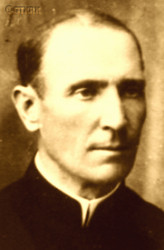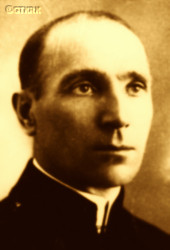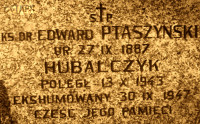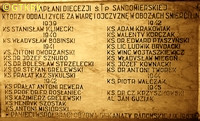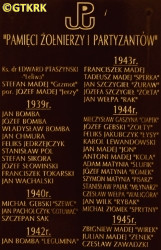Roman Catholic
St Sigismund parish
05-507 Słomczyn
85 Wiślana Str.
Konstancin deanery
Warsaw archdiocese, Poland
full list:
displayClick to display full list

searchClick to search full list by categories
wyświetlKliknij by wyświetlić pełną listę po polsku

szukajKliknij by przeszukać listę wg kategorii po polsku

Martyrology of the clergy — Poland
XX century (1914 – 1989)
personal data
surname
PTASZYŃSKI
forename(s)
Edward
function
diocesan priest
creed
Latin (Roman Catholic) Church RCmore on
en.wikipedia.org
[access: 2014.09.21]
diocese / province
Sandomierz diocesemore on
en.wikipedia.org
[access: 2013.05.19]
RC Military Ordinariate of Polandmore on
en.wikipedia.org
[access: 2014.12.20]
academic distinctions
Doctor of Philosophy
honorary titles
Gold „Cross of Merit”more on
Gold „Cross of Merit”
(26.10.1938)
date and place
of death
13.10.1943

Brudzewice‐Koloniatoday: Poświętne gm., Opoczno pov., Łódź voiv., Poland
more on
en.wikipedia.org
[access: 2022.02.14]
alt. dates and places
of death
Grabinytoday: Opoczno pov., Łódź voiv., Poland
details of death
After German and Russian invasion of Poland in 09.1939 and start of the World War II, started collaboration with Mjr Henry Dobrzański's (nom‐de‐guerre „Hubal”) units that did not surrender after Polish defeat in 09.1939 and start of German occupation.
Helped in recruitment of partisans, collected weapons.
Provided shelter to the wounded — especially after the victorious battle with Germans in Hucisko on 30.03.1940.
Pursued by the Germans joined Mjr „Hubal”'s unit n. Radoszyce on 06.04.1940.
After „Hubal”'s death on 30.04.1940 near Anielin, went into hiding in Rzeszyca under Francis Mieczkowski name.
Collaborated with resistance Armed Struggle Union ZWZ (part of Polish Clandestine State) under nom‐de‐guerre „Leliwa”.
Helped to set up partisan units n. Rzeczyca and Inowłódz.
Later moved to Kraśnica and found shelter at local miller.
When Germans caught his scent moved to a forest keeper's Grabiny cottage in Brudzewice forests.
Murdered in unknown circumstances (banditry, Russian partisans).
Germans were searching for him till the end of war.
cause of death
murder
perpetrators
Russians / Poles (?)
sites and events
GeneralgouvernementClick to display the description, Ribbentrop‐MolotovClick to display the description, Pius XI's encyclicalsClick to display the description
date and place
of birth
24.09.1887Birth certification on:
photos.szukajwarchiwach.gov.pl
[access: 2025.09.18]

Glinicetoday: district of Radom, Radom city pov., Masovia voiv., Poland
more on
en.wikipedia.org
[access: 2021.09.29]
parents
PTASZYŃSKI Michael
🞲 ?, ? — 🕆 ?, ?

ULATOWSKA Rosalie
🞲 ?, ? — 🕆 ?, ?
baptism
02.10.1887Birth certification on:
photos.szukajwarchiwach.gov.pl
[access: 2025.09.18]

Radomtoday: Radom city pov., Masovia voiv., Poland
more on
en.wikipedia.org
[access: 2021.09.29]
St John the Baptist RC church
presbyter (holy orders)
ordination
17.07.1910

positions held
10.08.1936 – 1940
parish priest — Ruski Bródtoday: Przysucha gm., Przysucha pov., Masovia voiv., Poland
more on
en.wikipedia.org
[access: 2021.09.29] ⋄ St Therese of the Child Jesus RC parish ⋄ Końskietoday: Końskie gm., Końskie pov., Holy Cross voiv., Poland
more on
en.wikipedia.org
[access: 2021.05.30] RC deanery
08.08.1934 – 1936
parish priest — Kurozwękitoday: Staszów gm., Staszów pov., Holy Cross voiv., Poland
more on
en.wikipedia.org
[access: 2025.01.12] ⋄ Assumption of the Blessed Virgin Mary RC parish ⋄ Staszówtoday: Staszów gm., Staszów pov., Holy Cross voiv., Poland
more on
en.wikipedia.org
[access: 2021.09.29] RC deanery
04.1932 – 1934
parish priest — Chotczatoday: Chotcza Dolna, Chotcza gm., Lipsko pov., Masovia voiv., Poland
more on
en.wikipedia.org
[access: 2021.09.29] ⋄ Holy Trinity RC parish ⋄ Solectoday: Solec nad Wisłą, Solec nad Wisłą gm., Lipsko pov., Masovia voiv., Poland
more on
en.wikipedia.org
[access: 2021.07.18] RC deanery
12.05.1929 – 1932
parish priest — Zagożdżontoday: historical part of Pionki, Pionki gm., Radom pov., Masovia voiv., Poland
more on
en.wikipedia.org
[access: 2022.07.16] ⋄ St Barbara the Virgin and Martyr RC parish ⋄ Kozienicetoday: Kozienice gm., Kozienice pov., Masovia voiv., Poland
more on
en.wikipedia.org
[access: 2021.12.19] RC deanery — builder of a new church
06.1923 – 1929
curatus/rector/expositus — Zagożdżontoday: historical part of Pionki, Pionki gm., Radom pov., Masovia voiv., Poland
more on
en.wikipedia.org
[access: 2022.07.16] ⋄ RC chapel ⋄ Goryńtoday: Jastrzębie gm., Radom pov., Masovia voiv., Poland
more on
en.wikipedia.org
[access: 2021.09.29], Assumption of the Blessed Virgin Mary RC parish ⋄ Jedlińsktoday: Jedlińsk gm., Radom pov., Masovia voiv., Poland
more on
en.wikipedia.org
[access: 2021.09.29] RC deanery
10.1919 – 1923
parish priest — Wolanówtoday: Wolanów gm., Radom pov., Masovia voiv., Poland
more on
en.wikipedia.org
[access: 2021.09.29] ⋄ St Dorothy RC parish ⋄ Radomtoday: Radom city pov., Masovia voiv., Poland
more on
en.wikipedia.org
[access: 2021.09.29] RC deanery
11.07.1918 – 1919
curatus/rector/expositus — Rytwianytoday: Rytwiany gm., Staszów pov., Holy Cross voiv., Poland
more on
en.wikipedia.org
[access: 2025.08.19] ⋄ Annunciation to the Blessed Virgin Mary RC church (post‐Camaldulian) ⋄ Staszówtoday: Staszów gm., Staszów pov., Holy Cross voiv., Poland
more on
en.wikipedia.org
[access: 2021.09.29], St Bartholomew the Apostle RC parish ⋄ Staszówtoday: Staszów gm., Staszów pov., Holy Cross voiv., Poland
more on
en.wikipedia.org
[access: 2021.09.29] RC deanery
07.1917 – 1918
prefect — Kozienicetoday: Kozienice gm., Kozienice pov., Masovia voiv., Poland
more on
en.wikipedia.org
[access: 2021.12.19] ⋄ Holy Cross RC parish ⋄ Kozienicetoday: Kozienice gm., Kozienice pov., Masovia voiv., Poland
more on
en.wikipedia.org
[access: 2021.12.19] RC deanery — also: co‐founder of the first secondary school in Kozienice — on 07.11.1917 member of the Committee for the Establishment of the Secondary School in Kozienice, on 01.12.1917 member of the school's Guardianship Council, from 12.1917 prefect and teacher of German (the school began operating before obtaining permission from the German occupation authorities, officially from 1918after being granted a concession)
1916 – 1917
prefect — Skarżysko Kościelnetoday: Skarżysko Kościelne gm., Skarżysko‐Kamienna pov., Holy Cross voiv., Poland
more on
en.wikipedia.org
[access: 2021.09.29] ⋄ Holy Trinity RC parish ⋄ Iłżatoday: Iłża gm., Radom pov., Masovia voiv., Poland
more on
en.wikipedia.org
[access: 2021.09.29] RC deanery — in Kamienna and Skarżysko Kościelne, also German language teacher
07.1915 – 1916
vicar — Łoniówtoday: Łoniów gm., Sandomierz pov., Holy Cross voiv., Poland
more on
wpolityce.pl
[access: 2021.09.02] ⋄ St Nicholas the Bishop and Confessor RC parish ⋄ Sandomierztoday: Sandomierz urban gm., Sandomierz pov., Holy Cross voiv., Poland
more on
en.wikipedia.org
[access: 2021.09.29] RC deanery
1913 – 1915
PhD student — Fribourgtoday: Fribourg can., Switzerland
more on
en.wikipedia.org
[access: 2021.07.25] ⋄ philosophy, Lat. Universitas Friburgensis (Eng. University of Fribourg) — doctoral dissertation on Stanislav Staszic, public defense in 1915; based on it, published „Staszic's Views on Upbringing”, Lublin 1927
1912 – 1913
student — Krakówtoday: Kraków city pov., Lesser Poland voiv., Poland
more on
en.wikipedia.org
[access: 2021.06.07] ⋄ Polish language, Department of Philosophy, Jagiellonian University UJ — post‐graduate studies
1910 – c. 1912
student — Fribourgtoday: Fribourg can., Switzerland
more on
en.wikipedia.org
[access: 2021.07.25] ⋄ philosophy, Lat. Universitas Friburgensis (Eng. University of Fribourg) — post‐graduate studies; Convict „Salesianum” resident
1904 – 1910
student — Sandomierztoday: Sandomierz urban gm., Sandomierz pov., Holy Cross voiv., Poland
more on
en.wikipedia.org
[access: 2021.09.29] ⋄ philosophy and theology, Theological Seminary
sites and events
descriptions
Generalgouvernement: After the Polish defeat in the 09.1939 campaign, which was the result of the Ribbentrop‐Molotov Pact and constituted the first stage of World War II, and the beginning of German occupation in part of Poland (in the other, eastern part of Poland, the Russian occupation began), the Germans divided the occupied Polish territory into five main regions. In two of them new German provinces were created, two other were incorporated into other provinces. However, the fifth part was treated separately, and in a political sense it was supposed to recreate the German idea from 1915 (during World War I, after the defeat of the Russians in the Battle of Gorlice in 05.1915) of creating a Polish enclave within Germany. Illegal in the sense of international law, i.e. Hague Convention, and public law, managed by the Germans according to separate laws — especially established for the Polish Germ. Untermenschen (Eng. subhumans) — till the Russian offensive in 1945 it constituted part of the Germ. Großdeutschland (Eng. Greater Germany). Till 31.07.1940 formally called Germ. Generalgouvernement für die besetzten polnischen Gebiete (Eng. General Government for the occupied Polish lands) — later simply Germ. Generalgouvernement (Eng. General Governorate), as in the years 1915‐1918. From 07.1941, i.e. after the German attack on 22.06.1941 against the erstwhile ally, the Russians, it also included the Galicia district, i.e. the Polish pre‐war south‐eastern voivodeships. A special criminal law was enacted and applied to Poles and Jews, allowing for the arbitrary administration of the death penalty regardless of the age of the „perpetrator”, and sanctioning the use of collective responsibility. After the end of the military conflict of the World War UU, the government of the Germ. Generalgouvernement was recognized as a criminal organization, and its leader, governor Hans Frank, guilty of war crimes and crimes against humanity and executed. (more on: en.wikipedia.orgClick to attempt to display webpage
[access: 2024.12.13])
Ribbentrop‐Molotov: Genocidal Russian‐German alliance pact between Russian leader Joseph Stalin and German leader Adolf Hitler signed on 23.08.1939 in Moscow by respective foreign ministers, Mr. Vyacheslav Molotov for Russia and Joachim von Ribbentrop for Germany. The pact sanctioned and was the direct cause of joint Russian and German invasion of Poland and the outbreak of the World War II in 09.1939. In a political sense, the pact was an attempt to restore the status quo ante before 1914, with one exception, namely the „commercial” exchange of the so‐called „Kingdom of Poland”, which in 1914 was part of the Russian Empire, fore Eastern Galicia (today's western Ukraine), in 1914 belonging to the Austro‐Hungarian Empire. Galicia, including Lviv, was to be taken over by the Russians, the „Kingdom of Poland” — under the name of the General Governorate — Germany. The resultant „war was one of the greatest calamities and dramas of humanity in history, for two atheistic and anti‐Christian ideologies — national and international socialism — rejected God and His fifth Decalogue commandment: Thou shall not kill!” (Abp Stanislav Gądecki, 01.09.2019). The decisions taken — backed up by the betrayal of the formal allies of Poland, France and Germany, which on 12.09.1939, at a joint conference in Abbeville, decided not to provide aid to attacked Poland and not to take military action against Germany (a clear breach of treaty obligations with Poland) — were on 28.09.1939 slightly altered and made more precise when a treaty on „German‐Russian boundaries and friendship” was agreed by the same murderous signatories. One of its findings was establishment of spheres of influence in Central and Eastern Europe and in consequence IV partition of Poland. In one of its secret annexes agreed, that: „the Signatories will not tolerate on its respective territories any Polish propaganda that affects the territory of the other Side. On their respective territories they will suppress all such propaganda and inform each other of the measures taken to accomplish it”. The agreements resulted in a series of meeting between two genocidal organization representing both sides — German Gestapo and Russian NKVD when coordination of efforts to exterminate Polish intelligentsia and Polish leading classes (in Germany called «Intelligenzaktion», in Russia took the form of Katyń massacres) where discussed. Resulted in deaths of hundreds of thousands of Polish intelligentsia, including thousands of priests presented here, and tens of millions of ordinary people,. The results of this Russian‐German pact lasted till 1989 and are still in evidence even today. (more on: en.wikipedia.orgClick to attempt to display webpage
[access: 2015.09.30])
Pius XI's encyclicals: Facing the creation of two totalitarian systems in Europe, which seemed to compete with each other, though there were more similarities than contradictions between them, Pope Pius XI issued in 03.1937 (within 5 days) two encyclicals. In the „Mit brennender Sorge” (Eng. „With Burning Concern”) published on 14.03.1938, condemned the national socialism prevailing in Germany. The Pope wrote: „Whoever, following the old Germanic‐pre‐Christian beliefs, puts various impersonal fate in the place of a personal God, denies the wisdom of God and Providence […], whoever exalts earthly values: race or nation, or state, or state system, representatives of state power or other fundamental values of human society, […] and makes them the highest standard of all values, including religious ones, and idolizes them, this one […] is far from true faith in God and from a worldview corresponding to such faith”. On 19.03.1937, published „Divini Redemptoris” (Eng. „Divine Redeemer”), in which criticized Russian communism, dialectical materialism and the class struggle theory. The Pope wrote: „Communism deprives man of freedom, and therefore the spiritual basis of all life norms. It deprives the human person of all his dignity and any moral support with which he could resist the onslaught of blind passions […] This is the new gospel that Bolshevik and godless communism preaches as a message of salvation and redemption of humanity”… Pius XI demanded that the established human law be subjected to the natural law of God , recommended the implementation of the ideal of a Christian state and society, and called on Catholics to resist. Two years later, National Socialist Germany and Communist Russia came together and started World War II. (more on: www.vatican.vaClick to attempt to display webpage
[access: 2023.05.28], www.vatican.vaClick to attempt to display webpage
[access: 2023.05.28])
sources
personal:
www.majorhubal.plClick to attempt to display webpage
[access: 2013.06.11], pl.wikipedia.orgClick to attempt to display webpage
[access: 2013.06.11], bdsandomierz.plClick to attempt to display webpage
[access: 2025.01.12], photos.szukajwarchiwach.gov.plClick to attempt to display webpage
[access: 2025.09.18], www.katolicy.euClick to attempt to display webpage
[access: 2021.12.19], bc.radom.plClick to attempt to display webpage
[access: 2025.08.19]
original images:
www.majorhubal.plClick to attempt to display webpage
[access: 2013.06.11], commons.wikimedia.orgClick to attempt to display webpage
[access: 2015.05.09], www.majorhubal.plClick to attempt to display webpage
[access: 2013.06.11], www.youtube.comClick to attempt to display webpage
[access: 2024.12.13], mazowieckie.fotopolska.euClick to attempt to display webpage
[access: 2019.10.13]
LETTER to CUSTODIAN/ADMINISTRATOR
If you have an Email client on your communicator/computer — such as Mozilla Thunderbird, Windows Mail or Microsoft Outlook, described at WikipediaPatrz:
en.wikipedia.org, among others — try the link below, please:
LETTER to CUSTODIAN/ADMINISTRATORClick and try to call your own Email client
If however you do not run such a client or the above link is not active please send an email to the Custodian/Administrator using your account — in your customary email/correspondence engine — at the following address:

giving the following as the subject:
MARTYROLOGY: PTASZYŃSKI Edward
To return to the biography press below:
 Click to return to biography
Click to return to biography








